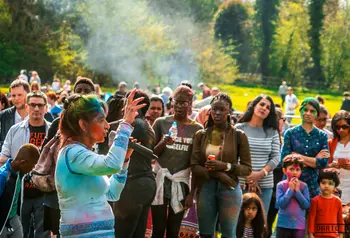Space to Thrive report
| Attachment | Size |
|---|---|
| Space to thrive - a rapid evidence review | 1.85 MB |
Overview
The Space to Thrive report was conducted by researchers from Sheffield Hallam University and The University of Sheffield. It was produced with The National Lottery Community Fund.
It is based on a review of 385 papers published within the last ten years. Each have been through a process of academic peer review.
It focuses on issues such as health, wellbeing and social integration.
- Read CEO of Mind Paul Farmer's blog: How green spaces can improve our wellbeing
- Hear from one of the report’s researchers, Julian Dobson, about the impact of parks on health, wellbeing and society
Key findings
1. Access to and use of parks and green spaces enhance physical health, mental wellbeing and life satisfaction
People need parks and green spaces nearby, but they need to be of a sufficient quality to encourage regular visits. The quality of green spaces has a stronger bearing on health outcomes than quantity.
Visiting parks can help reduce obesity, diabetes and heart disease. Visits to green spaces support mental wellbeing and stress relief.
2. Parks can create important opportunities for social integration
Parks can help refugees and migrants establish a sense of belonging in new communities.
But they can also amplify social divisions. Groups may exclude themselves from green spaces if they feel the space is dominated by one particular group of users (for example, if a park is overwhelmingly used by young people) or if they feel unsafe (for example, when a space is poorly maintained or attracts antisocial behaviour).
3. Parks provide opportunities for community engagement
Local residents, including children, value the chance to be involved in designing and improving their green spaces (for example, through volunteering).
Community gardening offers opportunities for new residents to build social connections.
Schemes to include young people in the care of green spaces can enhance their personal development and increase their environmental awareness.
4. Parks and green spaces highlight inequalities in society
There is evidence that the quality of parks and green spaces is worse in lower-income areas. Minorities are often marginalised in terms of access to green space.
5. Parks and green spaces enable people to connect with nature, which enhances their sense of wellbeing
Connectedness with nature includes experiencing the natural world through the physical senses, learning about it, and engaging mindfully with nature by paying attention.
It is associated with a sense of gratitude and self worth and can help people recover from stress and mental illness.
Connections with nature also help to build a sense of place and community and foster feelings of belonging.
6. Parks and green spaces can have economic benefits
Including:
- creating employment
- hosting economic activities (such as cafes or events)
- encouraging inward investment
Recommendations
1. Parks should be seen as social as well as physical infrastructure
This means that as well as investing in and maintaining high-quality physical environments, funders should also support the activities that animate green spaces and encourage people to use them. Investment should support activities that increase community engagement, bring different social groups together, encourage volunteering and open up parks to disadvantaged sections of society.
For example by:
- funding local groups to provide community development activities in green spaces
- creating welcoming meeting spaces such as cafés
- ensuring high standards of care and maintenance are provided to deter crime, littering and antisocial behaviour
2. Parks and green spaces should be managed to support health and wellbeing
Design, maintenance and activities should encourage physical exercise appropriate for all sections of the population. They should also create restorative spaces and activities that enable people to recover from the stresses of life. For example:
- funding social prescribing within green environments
- supporting fitness and exercise activities in parks in low-income areas
- improving lighting and pathways to increase a sense of safety and security
3. Parks and green spaces should be managed to encourage connections with nature
A wide range of habitats should be provided to give visitors the opportunity to engage with and better understand the natural world. This in turn will maximise the wellbeing benefits associated with nature connectedness.


